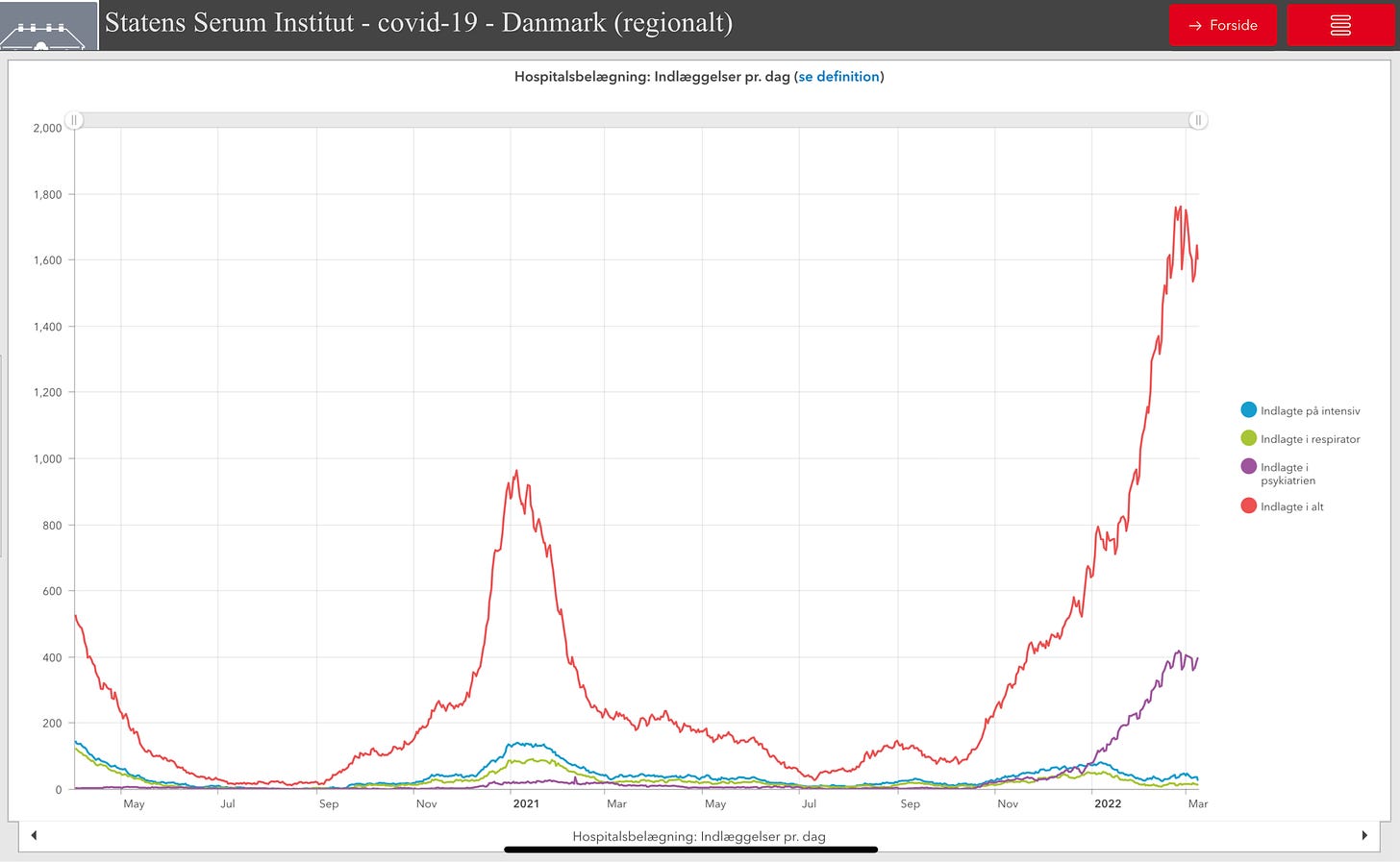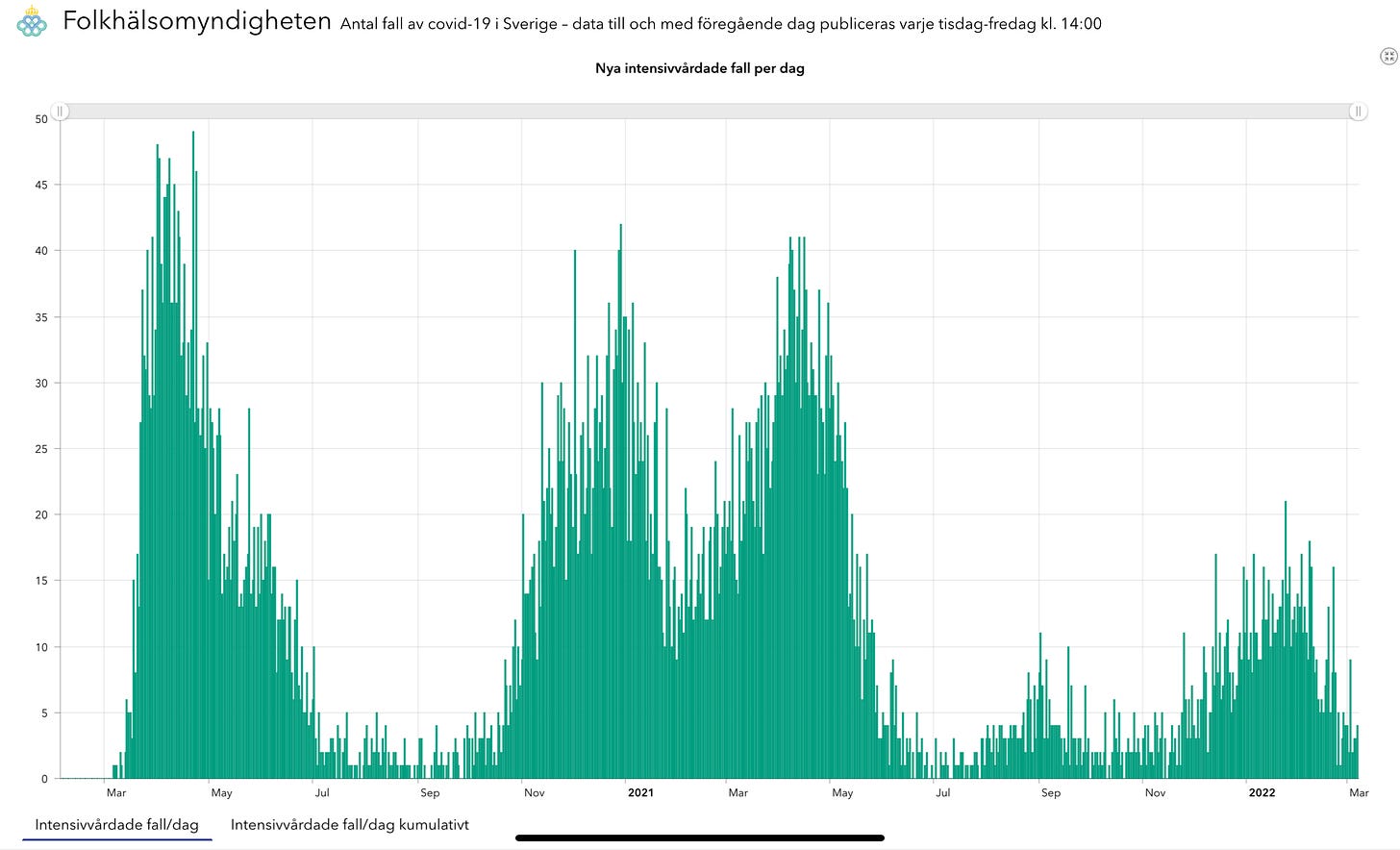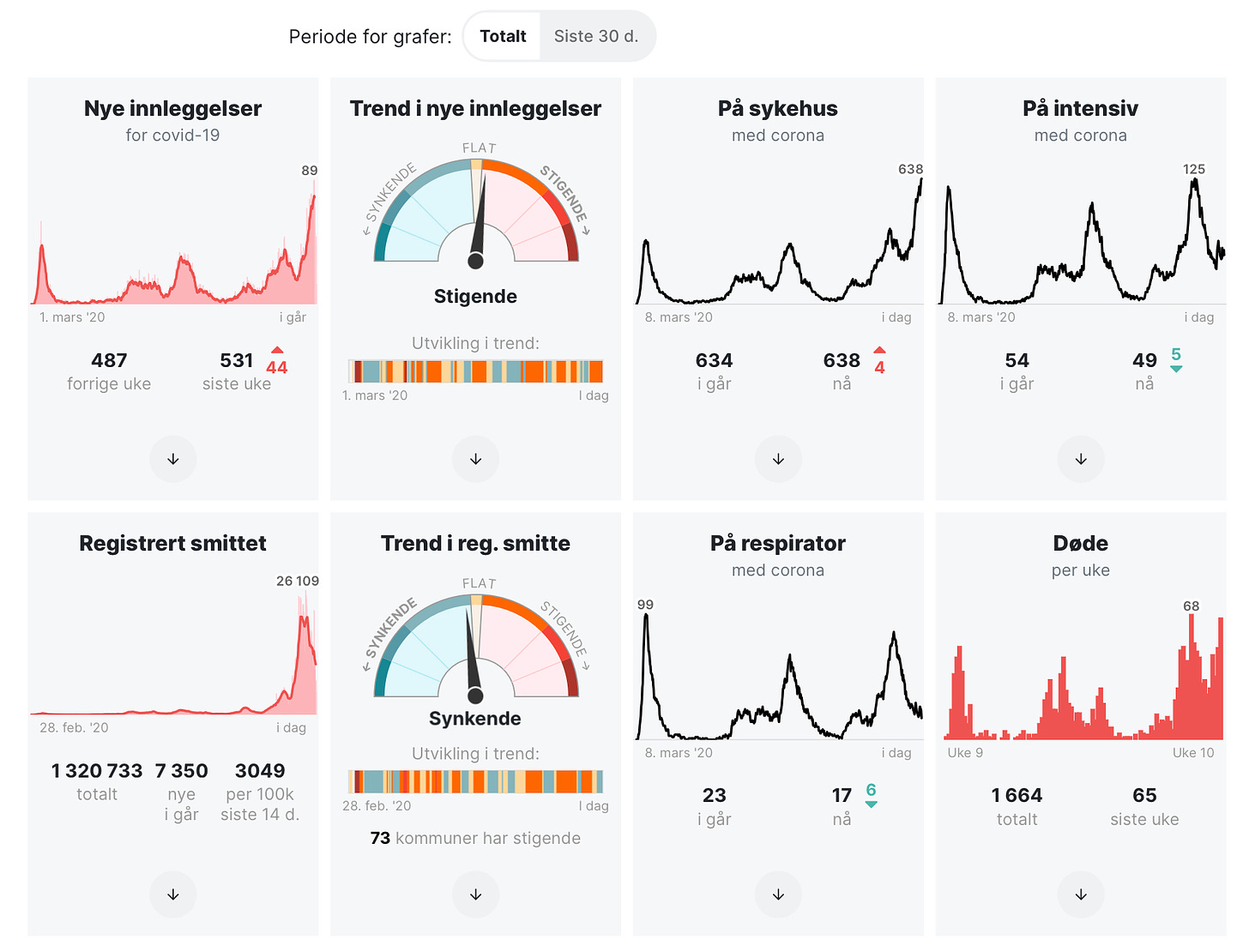The Evening Report - Mar 8
Russia threatens to turn the gas taps off. Denmark’s COVID wave eases.
🇺🇦/🇷🇺 War
🇷🇺 🇪🇺
For the first time since its invasion of Ukraine and after a barrage of global sanctions levied against it, Russia is threatening to cut gas supplies to Europe. In a speech on state television, Russian Deputy Prime Minister Alexander Novak said Russia has the right to “impose an embargo on the transit of gas through the Nord Stream 1 pipeline.” In making the threat, Novak made it clear that if they followed through it would be in retaliation for western sanctions and especially those coming from the European Union.
Danske Bank Chief Analyst Jens Nærvig Pedersen says it is important to distinguish between short-term and medium-term consequences. In the short-term, the EU experiences an energy crunch, which will get worse if Russia cuts off its supply of gas. But, he notes, Europe has some expensive alternatives to Russian gas. He adds if Russia cuts off gas supplies to Europe it will inflict pain, but it would also provide immediate incentives for the EU to divest itself of Russian gas in a hurry.
Pederson also notes Russia’s timing in making the threat is less than ideal as spring is coming and as temperatures warm heating demand will drop.
“Russia can't easily sell its gas to other countries, even if sanctions permit this. Pipelines go to Europe and it takes time (and money) to expand gas networks, e.g. to Asia. So the bottom line is the EU probably has the upper hand in this gas game of chicken.”
Also worth factoring in are the financial situation of Gazprom, Russia’s state-owned energy company, who would be on the hook for huge financial damages if it reneges on gas contracts. The Wall Street Journal is already reporting Gazprom is facing foreign debt repayments.
Russia is considered Europe’s largest oil supplier but in the aftermath of its disastrous invasion of Ukraine, Denmark, and the European Union as a whole, are now looking to end energy reliance on Russia as fast as possible.
🇩🇰/🇳🇴
Norwegian Prime Minister Jonas Gahr Støre is making an official state visit to Denmark on Wednesday. He will meet with Danish Statsminister Mette Frederiksen to discuss the Russian invasion of Ukraine, NATO cooperation, and energy security. The energy topic is particularly interesting as Denmark, and Europe as a whole, looks to end its reliance on Russian oil and gas. Norway is building the Baltic pipeline, which will transport natural gas from Norway to Poland through Denmark.
🇩🇰/NATO
NATO continues to build up its forces along the Russian border across European member countries. Another 200 Danish soldiers have arrived in Estonia to bolster NATO forces there. They arrived along with more military vehicles and equipment.
🇩🇰/🇺🇦
Denmark’s Ministry of Foreign Affairs is looking for ways to evacuate about 70 or so Danes who are in Ukraine and trying to leave the war-torn country. Among the options on the table are a possible evacuation by bus from Lviv in Ukraine to Warsaw in Poland. But the ministry tells Ritzau that the security situation in Ukraine is so volatile that any evacuation plan, by bus or otherwise, could prove to be impossible.
-
On Tuesday, the number of Ukrainian refugees fleeing the war-torn country passed two-million people. As part of preparations to receive refugees Region Sjælland has set up a mobile health clinic in Rødbyhavn. The clinic has treatment rooms, emergency medicine, and other medical equipment like defibrillators.
Chief Consultant Bettina Tomczyk:
“We are ready, and we have arranged the set-up both for easier treatment and to make health professional assessments of those who come here. But we do not know how many it will be, nor do we know when we will start.”
The Danish National Health Board is also putting plans in place to deal with any war injuries, medical needs, and infections among fleeing Ukrainians.
-
As Danish health authorities prepare for a possible influx of Ukrainian refugees, they are also cognizant that they will be traumatized to varying degrees. The Danish National Health Board is working with the regions to prepare to not only assess the physical well-being of the refugees but also their mental health. If refugees need it they can have crisis interviews with the ability to access psychiatric help if needed. This would also apply to traumatized young children.
-
Region Sjælland is also opening up job opportunities for at least 200 Ukrainian refugees. They would be service jobs, which would not require workers to know Danish.
-
Denmark is providing help to Danish companies looking to wind down their business in Russia and exit the country.
Foreign Affairs Minister Jeppe Kofod spoke at a press conference on Monday:
“As something new, we will offer advice with a view to ending cooperation with Russia and phasing out existing business activities. Right now, it does not make sense at all to provide advice for new export efforts in Russia or to expand activities in that market.”
-
The Danish Agency for Patient Safety has also established a hotline for professional health advice pertaining to issues Ukrainian refugees in Denmark might have.
Director Anette Lykke Petri:
“The agency can advise authorities on everything from preventive measures for infectious diseases, hygiene issues, and the right to healthcare in Denmark.”
-
There is a Ukrainian flag now flying alongside the Danish dannebrog outside Region Syddanmark’s buildings in Vejle to show solidarity with Ukrainians. The region says it is ready to help Ukrainian refugees with any healthcare needs they might have. It is also coordinating with the other regions and Ministry of Health donations to gather donations to be sent to Ukraine.
🇳🇴
Norway is offering a wide range of medical assistance to Ukraine. The Norwegian Health Ministry notes the war has led to a shortage of life-saving medicines like antibiotics, insulin, and heart medication. To help alleviate the need, Norway is sending 43-million Norwegian kroner (about $6.1 million Cdn) worth of medication to Ukraine.
Health Minister Ingvild Kjerkol:
“We must help each other when a crisis strikes. We know that it is a challenge to provide help to anyone who needs medical treatment and that the Ukrainian health service is under enormous pressure. It is an obvious need that Norway can contribute some help to in this situation.”
The delivery of medicine will be coordinated through the EU’s civil preparedness scheme. The first shipments of medication have already arrived in Poland.
It is not just medication either.
“Our Emergency Medical Team is now on standby to be able to quickly assist if there is a need to support local health services in Ukraine's neighboring countries.”
The Norwegian health ministry has also done an assessment of its hospital system and says it can handle around 550 Ukrainian patients including children, burn victims, and those needing cancer treatment. Patients could be medevaced to Norway if needed. Norway operates its own ambulance aircraft, which can be seconded to the EU’s civil emergency authority.
🇨🇦
Canada has added to the pile of sanctions on Russia for its invasion of Ukraine. Prime Minister Justin Trudeau announced on Monday that an additional ten people linked to the Russian government will face new sanctions.
“They include former and current senior government officials, oligarchs, and people who support the Russian leadership.
To add to the sting of the new sanctions, the ten people are off a list from imprisoned Russian opposition leader Alexei Navalny. They are Mikhail Murashko, Dmitry Patrushev, Vladimir Solovyov, Margarita Simonyan, Oleg Deripaska, Pavel Krasheninnikov, Victor Gavrilov, Dmitry Ivanov, Konstantin Ernst, and Dmitry Peskov.
Trudeau is currently in Europe to have a series of meetings with various officials and heads of state over Russia’s invasion of Ukraine. He was in the United Kingdom Monday but flew into Latvia that night for more meetings. The United States Secretary of State Anthony Blinken is also in Latvia.
🦠Pandemic🦠
🇩🇰
Denmark’s COVID contact number (reinfection rate or R0) rose slightly week to week, going from 0.7 last week to 0.8 this week. Danish Health Minister Magnus Heunicke says this still indicates that Denmark has a declining epidemic. Heunicke also says there are “indications” new COVID hospitalizations are also decreasing.
Heunicke is also pointing to other indicators as hopeful signs that this latest infection wave is easing. He says infection rates are falling among older age groups, which could lead to fewer hospitalizations and coronavirus deaths in the coming weeks.
The one caution is that because of falling testing numbers, the reliability of accurately assessing infection rates has taken a big hit.
Infection rates by age over the last seven days are in the chart below.
-
COVID hospitalizations (1,602) have dropped (-42) while the number of severe infection cases in an ICU (27) also fell (-10) and of those the number on a ventilator (13) also declined slightly (-2) while admissions to a psychiatric ward (398) are up (+8).
-
Denmark reported 15,475 COVID infections (underreported) including 856 reinfections, and 43 more coronavirus deaths in the last day. Reported deaths are measured as fatalities within four weeks of a positive test result. The Statens Serum Institut updates statistics on Thursdays of deaths as measured by those who died because of an infection and those who died for another reason but with an infection.
Yesterday there were 63,257 total corona tests done, of which 61,641 were PCR tests equaling a positivity percentage of 25.10%.
-
After closing all of its rapid testing sites on Sunday, Region Nordjylland is now scaling down its PCR testing facilities as well. The region says on March 13, nine of the 22 PCR COVID testing sites in North Jutland will close their doors.
Health Planning Office Manager Jacob Bertramsen:
“We are seeing declining infection numbers in society at the moment, and it is estimated that it will continue due to increasing immunity and seasonal effects. As a result, we are reducing testing capacity, as we are not experiencing the same needs as before.”
On February 28, the Danish National Health Board introduced a stair model for PCR testing. If demand kept declining past certain benchmarks, then it would trigger a reduction in overall PCR testing capacity. On the 28th, the national PCR testing capacity in Denmark was reduced from 200,000 daily tests to 140,000. Now Region Nordjylland says capacity has been scaled down again this week to 100,000 daily tests.
Below is a map of the nine PCR testing sites that will close this Sunday.
-
On the vaccination front, there were just 813 booster doses administered yesterday as inoculation efforts trudge along.
To date, 82.4% of the total population have one vaccine dose, 81% have two, and 61.2% have a booster dose.
-
Danish health authorities have noted another side effect of the COVID pandemic. The Statens Serum Institut says there were just 80 cases of whooping cough (pertussis) in all of 2021.
Ward Doctor Peter Henrik Andersen:
“From the summer of 2020 and the rest of the year as well as throughout 2021, the number of pertussis cases was very low. It was an average of 6.7 cases per month, which is the lowest we have seen since monitoring of whooping cough was introduced in its current form.”
The drop is especially dramatic because in 2019 there was a widespread whooping cough epidemic. Cases almost quadrupled compared to previous years, with the epidemic carrying over into early 2020. Then it came to a crashing halt and almost overnight, whooping cough all but vanished.
The SSI thinks the coronavirus pandemic and severe restrictions in Denmark and around the world helped put an end to the whooping cough pandemic.
“The low number of cases is most likely due to the COVID pandemic. At the same time, the increased immunity in the population after the pertussis epidemic 2019-20 has probably put a damper on infection with pertussis for some years to come. Just as we saw it after the minor pertussis epidemic in 2016.”
In 2020 and 2021, there were 122 total whooping cough cases in Denmark among children under the age of two. 26% of them had not been vaccinated against pertussis.
🇸🇪
Sweden added 37 coronavirus deaths and another 4,817 corona infections (wildly underreported) since its last update on Friday.
To date, 86.9% of the population 12 years old and older have one vaccine dose, 84.5% have two, and of those 18 years old and older 60.8% have a booster shot.
-
The Swedish Public Health Agency is ending its weekly COVID press conferences that have been held very Thursday. The agency says coronavirus information will continue to be published online and agency spokespeople will remain available to the media.
Press Manager Christer Janson:
“Based on the development of the pandemic and the fact that we are now in a different phase, the public's and thus the media's interest in COVID is no longer as great and there is therefore no need for regular press conferences.“
-
The COVID hospitalization situation in Sweden’s capital region continues to improve although declined admissions have slowed. Region Stockholm says there are 384 coronavirus patients in hospital a week-over week decline of 12. There are also 14 severe infection cases in intensive care.
Chief Physician Elda Sparrelid:
“The number of people infected with COVID at our hospitals is declining, but now at a slower pace than in previous weeks. We really want to see a faster reduction right now. The best way to reduce the number of people who need to be cared for in a hospital is to vaccinate yourself with the doses you are offered. The vaccinations provide good protection against serious illnesses.”
None of Stockholm’s hospitals are on a COVID emergency footing anymore. As normal operations resume work is underway to deal with backlogged surgeries and procedures that were delayed or postponed due to the pandemic.
Region Stockholm says in the last seven days 1,784 corona infections have been confirmed (wildly underreported) while another 47 lives have been lost to the coronavirus.
-
The Swedish Public Health Agency is preparing for the arrival of the first doses of the Novavax COVID vaccine. The agency says there are about a million people in Sweden who haven’t yet been vaccinated. The hope is the Novavax vaccine, a more traditional protein-based vaccine, will help convince holdouts who might be suspicious of the two mRNA vaccines, Pfizer and Moderna.
The hearth agency says the Novavax vaccine is to be used for first, second, and third doses for adults 18 years old and older who have not yet been vaccinated. Doses should be given three to six weeks apart.
State Epidemiologist Anders Tegnell says doses can also be stored at regular refrigerator temperatures.
“It is important that everyone who is covered by the recommendations and can be vaccinated against COVID does so. It is and remains the most important tool for keeping the pandemic under control, and the vaccine protects both you and others.”
The first doses of Novavax are expected to arrive in Sweden within the next month. The vaccine was approved by the EU Commission in late December, but shipping issues have prevented doses from getting to Europe as fast as initially thought.
🇳🇴
In Norway, COVID hospitalizations (638) are up (+4) while the number of severely infected people in an ICU (49) dipped (-5) and of those the number on a ventilator (17) is also down (-6).
Norge has no new pandemic deaths and added 9,564 infections since yesterday.
To date, 80.3% of Norwegians 12 years old and older have one dose, 74.6% have two, and 53.6 have three.
🇫🇮
The Finnish Institute for Health says a technical issue is preventing it from reporting COVID infection and fatality numbers today. The agency is also going to reduce its pandemic reporting and beginning next week will only update coronavirus statistics once a week on Wednesdays.
COVID hospitalizations (813) are down (-14).
On the vaccination front, 79.4% of the total population have one dose, 75.6% have two, and 50% have a booster. Below is a vaccination chart by age and dose.
-
The Finnish Institute for Health has adjusted its COVID fatalities adding 184 pandemic related deaths over the last week. That pushes Finland’s total to-date coronavirus deaths to 2,571. The institute says the deaths were backlogged due to registration problems.
-
Finland's state railway firm VR has announced that it has changed its coronavirus-related requirement for train passengers to wear face masks on trains to a recommendation. While passengers are encouraged to wear a mask and follow other pandemic advice like trying to keep their distance and basic hygiene practices railway staff will continue to mask up regardless. The change came into force this past Monday.
🇮🇪
Ireland has abolished all COVID restrictions including entry rules at its borders. According to the Irish government, incoming travelers no longer need to show proof of vaccination or recovery from a recent infection. They also no longer need to fill out a passenger locator form prior to boarding.
Per the Irish government:
“There are no post-arrival testing or quarantine requirements for travellers to Ireland. Travel carriers will not ask to check a PLF receipt prior to travelling to Ireland. Any individual that develops COVID symptoms while in Ireland should follow the HSE (Health Service Executive) guidance in relation to isolation and undertaking antigen or PCR testing as appropriate.”
Anyone who is transiting through Ireland to North Ireland will still have to abide by United Kingdom travel requirements and entry restrictions.
WHO🌏🦠
The World Health Organization says the number of new global infections and deaths both declined last week by 5% and 8% respectively. That said, there were over 10-million new infections and over 52,000 deaths around the world.
The WHO says the Omicron variant is dominant in virtually every corner of the globe, with the Delta variant showing up in a shrinking number of cases.
Looking at the WHO’s six health regions numbers are down almost across the board. While cases dropped in the Eastern Mediterranean Region (-46%), the African Region (-40%), the South-East Asia Region (-31%), the Region of the Americas (-24%), and the European Region (-18%) they are rising in the Western Pacific Region (+46%). In the Western Pacific Region it is South Korea seeing the most new activity as new infections surged by 42% last week (1,461,431 infections) followed by Vietnam, where numbers were up 112% (1,013,343 new infections).
The WHO says the United States suffered the most COVID deaths of any country on earth last week, losing 10,579 more lives to the pandemic.
In the European region, while infection numbers have declined it still accounted for 45% of all new COVID infections in the world last week. Germany and Russia had the highest number of new cases and pandemic fatalities.
The WHO cautions that infection numbers are very uncertain due to testing changes in the different countries.
🌏🦠
Total to date global COVID deaths passed a grim milestone this week as they surpassed six-million lives lost. The United States has the most pandemic deaths of any country on earth, with 987,615 lives lost to date. It will pass the jaw-dropping one-million coronavirus deaths mark within a week.
It is important to note that the numbers above are likely very underreported. Several reports, including an exhaustive piece by the Wall Street Journal, estimate the ‘real’ pandemic death toll could be as much as three times higher.
🇨🇦
COVID hospitalizations across Canada continue to decline. According to the Public Health Agency of Canada, the total number of hospital beds occupied by a coronavirus patient in the last week of February was 5,136, a decline of 1,039 beds from the week before. Breaking it down to non-ICU hospitalizations numbers also dropped by 938 to 5,136. For intensive care, the number of occupied beds also decreased, going from 671 one week to 570 the next. There were also 70 fewer people on a ventilator in the last week of February.
Canada suffered another 53 pandemic deaths on Monday, pushing the total to date COVID deaths to over 37,000. It also added another 5,654 infections, a number that is very underreported.
-
The Canadian vaccination effort has so far administered 32,242,607 1st doses (84.32% of the total population) while 30,981,961 people (81.03%) have two doses, and of those, 17,778,954 people are fully vaccinated with three doses.
Updated numbers below focusing on more reliable indicators than case counts are in comparison to our last look at the provinces last Thursday.
In Ontario, COVID hospitalizations (779) fell (-55) while the number of severe infections in intensive care (246) has declined (-21). The province has a positivity percentage of 10.85%.
Quebec saw hospitalizations (1,252) drop (-112) while the number of severe infections in an ICU (77) inched up (+1). There were 29 more corona deaths. The province has a positivity percentage of 8.17%.
Newfoundland and Labrador has reduced its COVID updates to three times a week on Mondays, Wednesdays, and Fridays. As of its last update, it had 25 COVID patients in hospital, an increase of 10, with five people in an ICU. The province has a positivity percentage of 31.4%.
Nova Scotia has moved to weekly COVID updates, which are tabled on Thursdays.
New Brunswick is moving to once a week COVID updates beginning next week. It saw hospitalizations (99) increase (+10) while ICU numbers (12) also rose (+6). The province saw one more pandemic death. Hospital capacity is at 90% while ICU capacity sits at 77%.
Manitoba saw COVID hospitalizations (406) decline (-53) with 21 people in intensive care, a drop of eight. There were no new pandemic deaths. The province has a five-day positivity percentage of 13.9%.
Saskatchewan only updates its COVID statistics once a week on Thursdays.
COVID hospitalizations in Alberta (1,106) dropped (-98) while the number of people in an ICU (77) dipped (-3). There have been 7 more corona deaths. The province has a positivity percentage of 20.53%.
B.C. saw COVID hospitalizations (419) fall (-22) while the number of people with severe infections in an ICU (63) also dipped (-16). There has been one more pandemic death. The province has a positivity percentage of 6.30%.


















Thank you very much for the useful consolidations of information.